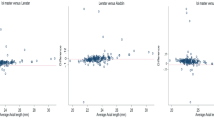Abstract
Purpose
To compare anterior segment measurements obtained using the Pentacam; Oculus, HR and the LenStar LS 900 in patients with newly diagnosed glaucoma.
Methods
Patients with ocular hypertension and primary open-angle glaucoma who had been treated with PGA were included in the study. Anterior segment measurements including central corneal thickness (CCT), keratometry, anterior chamber depth (ACD) and white-to-white (WTW) corneal diameter obtained with the optic low-coherent reflectometer (LenStar LS-900, Haag-Streit AG, Switzerland) and with the Scheimpflug system (Pentacam; Oculus, HR) were compared. In order to compare LenStar and Pentacam measurements, paired sample t test and ‘Bland–Altman’ plot were used in the statistical analysis.
Results
Twenty-two female (59.5%) and 15 male (40.5%) totally 37 cases with newly diagnosed glaucoma were included in the study. Anterior segment parameter measurements obtained with both the LenStar and the Pentacam were significantly correlated for right and left eyes, so the right eye values were used in statistical analysis. WTW and ACD values measured with LenStar were statistically significantly higher than those measured with Pentacam (p: 0.0001, p: 0.0001, respectively). There was no statistically significant difference between the CCT values measured by the two devices (p: 0.217).
Conclusion
There was a statistically significant difference between the mean values of ACD and WTW measured with the LenStar and Pentacam. These biometric devices should not be used interchangeably. It should be appropriate to use the same device on follow-up of glaucoma patients.


Similar content being viewed by others
References
Shih CY, Graff Zivin JS, Trokel SL et al (2004) Clinical significance of central corneal thickness in the management of glaucoma. Arch Ophthalmol 122:1270–1275
Herndon L, Weizer J, Stinnett S (2004) Central corneal thickness as a risk factor for advanced glaucoma damage. Arch Ophthalmol 122:17–21
American Academy of ophtalmology and Staff (2014–2015) Basic and Clinical Science Course-Glaucoma. United State of America. Section 10, p 113
Doors M, Cruysberg LP, Berendschot TT et al (2009) Comparison of central corneal thickness and anterior chamber depth measurements using three imaging technologies in normal eyes and after phakic intraocular lens implantation. Graefes Arch Clin Exp Ophthalmol 247:1139–1146
Li H, Leung CK, Wong L et al (2008) Comparative study of central corneal thickness measurement with slit-lamp optical coherence tomography and visante optical coherence tomography. Ophthalmology 115(796–801):e2
Razeghinejad MR, Lashkarizadeh H, Nowroozzadeh MH et al (2016) Changes in ocular biometry and anterior chamber parameters after pharmacologic mydriasis and peripheral iridotomy in primary angle closure suspects. J Optom S1888–4296(16):00003
OʼDonnell C, Hartwig A, Radhakrishnan H (2012) Comparison of central corneal thickness and anterior chamber depth measured using LenStar LS900, Pentacam, and Visante AS-OCT. Cornea 31(9):983–988
Bland JM, Altman DG (1986) Statistical methods for assessing agreement between two methods of clinical measurement. Lancet 1:307–310
Shajari M, Lehmann UC, Kohnen T (2016) Comparison of corneal diameter and anterior chamber depth measurements using 4 different devices. Cornea 35(6):838–842
American Academy of Ophtalmology (2014–2015) Basic and Clinical Science Course-Fundamentals and Principles of Ophthalmology. Section 2, pp 37–38
Devereux JG, Foster PJ, Baasanhu J et al (2000) Anterior chamber depth measurement as a screening tool for primary angle-closure glaucoma in an East Asian population. Arch Ophthalmol 118:257–263
Langenbucher A, Huber S, Nguyen NX et al (2003) Measurement of accommodation after implantation of an accommodating posterior chamber intraocular lens. J Cataract Refract Surg 29:677–685
Tsorbatzoglou A, Németh G, Széll N et al (2007) Anterior segment changes with age and during accommodation measured with partial coherence interferometry. J Cataract Refract Surg 33:1597–1601
Saxena R, Boekhoorn SS, Mulder PGH et al (2008) Long-term follow-up of endothelial cell change after Artisan phakic intraocular lens implantation. Ophthalmology 115:608–613
Domínguez-Vicent Alberto, Pérez-Vives Cari, Ferrer-Blasco Teresa et al (2016) Device interchangeability on anterior chamber depth and white -to -white measurements: a thorough literature review. Int J Ophthalmol 9(7):1057–1065
European Glaucoma Society (2014) Terminology and guidelines for glaucoma, 4th edition. PubliComm., Savona, pp 80–83
Gordon MO, Beiser JA, Brandt JD et al (2002) The Ocular Hypertension Treatment Study: baseline factors that predict the onset of primary open-angle glaucoma. Arch Ophthalmol 120(6):714–720
Leske MC, Heijl A, Hyman L, EMGT Group et al (2007) Predictors of long-term progression in the early manifest glaucoma trial. Ophthalmology 114(11):1965–1972
Barkana Y, Gerber Y, Elbaz U et al (2005) Central corneal thickness measurement with the Pentacam Scheimpflug system, optical low-coherence reflectometry pachymeter, and ultrasound pachymetry. J Cataract Refract Surg 31:1729–1735
Author information
Authors and Affiliations
Corresponding author
Ethics declarations
Conflict of interest
The authors of this manuscript named received no financial support or funds and have no financial interests related to this manuscript.
Rights and permissions
About this article
Cite this article
Sen, E., Inanc, M., Elgin, U. et al. Comparison of anterior segment measurements with LenStar and Pentacam in patients with newly diagnosed glaucoma. Int Ophthalmol 38, 171–174 (2018). https://doi.org/10.1007/s10792-016-0440-z
Received:
Accepted:
Published:
Issue Date:
DOI: https://doi.org/10.1007/s10792-016-0440-z




